

The Easiest Way To Master The Fretboard!
The series was developed visually, because people natively think visually. You do not have to interpret a picture. You can understand it by looking at it.
And when you combine it with knowledgable text, the meaning and rules of music will jump out at you!
Immediately you will begin to see into the instrument and develop an understanding that is not possible any other way.
This is one of the main reasons this series of books carry a lifetime guarantee. We back up our words with an iron clad policy that has been in place for years!
eBooks are delivered instantly!
I view buying a guitar, especially the first one as very important. This decision will play a part of your progress every day until you switch guitars. It will determine how easy or hard your guitar is to play and that will affect how fast you progress.
One of the problems a new guitar player will face is how to tell what guitar is best for you. This is complicated because usually beginners do not have the tactile response built up in their fingers yet. This is one of the benefits to playing scales but the skills usually take a few months to accrue. Until that time picking a guitar which you will use as the primary way you interact with music, may be difficult at best and possibly cause you to buy the wrong instrument.
This is just not a beginner topic. If you are looking for a quick boost for your playing, a new guitar may prove to be exactly what you need. I had this experience after I had played one for several years. My parents never had the money to invest into my hobby so I went for a while before I finally got a new instrument. My abilities were far more developed than a beginner but I was still playing a beginner guitar. When I finally bought my first serious guitar, I found an immediate spike in what I could do. Of course this caused me to play even more because it was more fun.
So there are a lot of considerations and we are going to discuss quite a few. The whole thing boils down to this. Develop your skills on whatever you have so you can judge for yourself and go play a bunch of guitars. Just keep telling yourself that you have to really like one before you can buy it. If you don't love it, then don't buy it.
A friend of mine has decided he is going to really apply himself and learn to play a guitar. He can play a little now but his knowledge base needs work and his fingers do not have strong tactile abilities built up yet. He is currently playing the scales I recommended and his initial report is his chording and song recitals have already improved beyond what it ever was.
Two weeks of playing scales and his excitement is greater now than ever before. This fellow has the means to buy a fine instrument but he does not know what to buy. He asked me to go play some guitars and report back to him. I declined the invitation. My reasoning was this.
He is not buying a guitar for me. He is buying one that will fit his personality and interests. I told him to wait a few more months until the level of skill in his hands begins to mature. Then when he finds one he likes, I will be happy to come down to the shop and evaluate it.
I believe there are three things that are important when you are selecting a new guitar. The first consideration for me is the feel of the guitar.
Feel. By far and away the most important consideration for me is the way the guitar feels when I play it. I break this down into three areas. Not surprisingly I examine how the guitar feels when I play scales, how it feels when I play chords, and how well I can play songs on it. The third criteria is quite different than the first two.
 Scales are
the easiest of the three aspects of evaluation with most guitars.
Playing single note lines is easier than playing three (or more) note`chords.
So I start by playing a few scale runs and determine how the guitar responds
and what kind of bite it has. Most of the time I play a new guitar, the
strings are somewhat old so the sound can be muted. This may hide the
true quality of the sound of the guitar.
Scales are
the easiest of the three aspects of evaluation with most guitars.
Playing single note lines is easier than playing three (or more) note`chords.
So I start by playing a few scale runs and determine how the guitar responds
and what kind of bite it has. Most of the time I play a new guitar, the
strings are somewhat old so the sound can be muted. This may hide the
true quality of the sound of the guitar.
You have to be careful about judging the sound of the instrument at first. You may not get a true reading. The room has something to do with this, just as the noise level in the shop influences the sound.
The feel of the guitar as I play scales is the first way I judge it. Are the strings a comfortable distance apart? There is a little difference in fretboard styles as some guitars have the strings closer together or slightly farther apart (see sidebar). All I am looking for are smooth transitions from string to string when I move across the fretboard. I am also noticing how much pressure it takes to hold the string down. Are my fingers hitting the strings at the correct location? Are my fingers quick to place themselves in the exact right location or do I have a little trouble when playing through the scale? Do it hurt to play this guitar?
By now, I expect to experience a smooth fluid sound and feel when I practice. I have played bad guitars as well as good ones and I have come to know what I like and dislike. I like guitars that are easy to play and that do not fight me when I try to play light and fast.
Keep in mind that string sets will vary in thickness and that will have a major effect on the feel of a guitar. I like light gauge strings. The span of thickness is from .10 for the high E string, to .46 for the low E string. If a guitar has thicker strings on it, it will be harder to press down but the tone may be better. The thicker the string, the better the tone.
If I don't get a fluid train of notes, I probably will not like the guitar. I want to focus on what I am trying to create rather than how to actually press the strings down. If I have to worry about hitting the strings correctly every time, that is time taken away from creativity. So I want medium-light fast action that I don't have to think about.
Action describes the feel of the guitar as you play it. To get light fast action, it usually means the strings are quite close to the fretboard, yet not close enough to buss when you play some chords.
 Chords are
the next way I will evaluate a new guitar. When I play a few chords,
these are the questions that I ponder.
Chords are
the next way I will evaluate a new guitar. When I play a few chords,
these are the questions that I ponder.
Are the chords comfortable to play? By now I know what they should feel like. They should be easy to hit exactly and I should be able to situate my fingers comfortably almost right away. Do the chords sound okay? Are some notes buzzing? I try to slow things down and listen to each string. This gives me a chance to make sure I stick the landing and have the greatest chance of playing the chord exactly correctly. If I run through the strings while holding down a chord, I listen for a buzzing sound or muting. Muting happens when my fingers do not press down the strings exactly and instead of sounding my fingers cause the note to deaden. Sometimes this is just a matter of getting warmed up and getting my muscles working together. Often times this takes 15 to 20 minutes before everything is working the way I like. You can hear it in the sound when things fall into place.
I try to play chords for ten minutes or so. I do this to gauge how fast initial fatigue will show up. This is another way to test the action. Barre chords will bring fatigue on faster than most open string chords. They are a little harder to play correctly and you are using all six strings and all four fingers so this will cause more fatigue.
If you have to struggle to press down the strings all the way, this will cause the muscles in your palm to fatigue faster. This can cause cramping. If you have not been playing regularly, this may intensify before your muscle groups become accustomed to the rigors of holding down strings. If fatigue shows up within the first ten minutes, it may be a sign that I am forced to put too much work into holding down the strings correctly.
 An acid
test is holding down a barre chord in the F major position. I consider
this one of the hardest chords to hold down because it is so close to
the nut of the guitar. It may not introduce fatigue until after several
minutes of playing it and moving in and out of the form. If fatigue shows
up too soon, it may be because the form is hard to hold down and my hands
are early indicators of a problem. At this point in my playing I can hold
down almost any chord and makes it sound good, but after some amount of
time, symptoms of hard action will show up. I don't like to work too hard
at playing chords. If after ten minutes or so, the guitar is still fighting
me, I will take a good look at the strings. If the strings are high off
the fretboard or heavy gauge, I will think about re stringing it or moving
on.
An acid
test is holding down a barre chord in the F major position. I consider
this one of the hardest chords to hold down because it is so close to
the nut of the guitar. It may not introduce fatigue until after several
minutes of playing it and moving in and out of the form. If fatigue shows
up too soon, it may be because the form is hard to hold down and my hands
are early indicators of a problem. At this point in my playing I can hold
down almost any chord and makes it sound good, but after some amount of
time, symptoms of hard action will show up. I don't like to work too hard
at playing chords. If after ten minutes or so, the guitar is still fighting
me, I will take a good look at the strings. If the strings are high off
the fretboard or heavy gauge, I will think about re stringing it or moving
on.
Here is the rub of doing this yourself. Everything I have mentioned implies you have the ability to play and judge for yourself. Anyone who has played for six months can do this, but a new player does not have the experience built up yet, so they can distinguish good from bad. So what do you do? How does a new guitar player proceed.
Asking someone to choose a guitar means either a really quick decision or a lot of their time. There can be complications to both of these choices. Another option is to get whatever guitar you can, and work the daylights out of it so you develop your ability quicker. Then go treat yourself for working so hard. I think this is the best way. It gives you something to look forward to. It becomes a milestone and it rewards hard work and determination.
Songs are the ultimate test of a guitar. Chords and scales are tools I use to play passages and songs I like. After my hands have warmed up and I have developed some opinions about the initial playability of the instrument, I will play a few parts of songs. I almost never play an entire song. I am not there to perform, I am there to judge an instrument. If you start playing whole songs you may attract attention and that will distract you from analyzing the instrument. Remember evaluating a new guitar is very important, do not allow distractions to get in the way.
When I play songs I know that in order for the quality of the song to show up, all the mechanics have to be right on the money. If everything is working right, a deep sense of rhythm will show up and guide the exact timing of my movements. If I start to play songs and I have to keep making small adjustments to get the sound and flow of my work dialed in, I will probably put the instrument down and never pick it up again. The songs must have a very good feel as I play them or no deal. This is a nonnegotiable point! The better the response, the quicker I will be able to concentrate on doing things exactly correctly and getting the sound I am after. Little nuances are so important that if they take too much work to create, then some of them don't happen. And that is no good!
When you are a new player and building up your basic skills, this analysis is too much to ask from yourself. That is why I advised my friend to build up his tactile response and hand strength before committing to an instrument. This is just too big of a decision to take chances with. A bad guitar will kill your desire to play it and with all the other concerns when you are learning, you cannot afford to throw a bad choice into the equation.
Kids
I see this mistake occur with parents that are trying to buy a guitar for their kids and justify a inexpensive guitar thinking they will reward their kid with a new guitar if they actually do learn. The problem is their child may not survive the guitar. Little hands need help too. This decision alone may kill the entire process before it ever starts. I have seen it happen. There is a trade off here and it can be hard to know what to do.
This is very understandable because the difference between a beginner guitar and an intermediate one, can mean a fair amount of money. But crippling your kid with an instrument he or she can't possibly play is dooming the process before it ever gets started. However that does not mean you have to spend a lot of money. I have seen beginner, 3/4 size guitars, for kids that have descent action. The sound is very plain because they are all glorified plywood boxes. There is no real spruce top to age and develop good sound. The resonator is tiny. So all the money should go into the feel.
So far we have covered feel, the other two components that go into buying a guitar are sound and looks. I put very little emphasis on looks. As long as I like the basic look of a guitar, that is all I really care about. Sound on the other hand is very important, but before we discuss sound, let's look at some construction concerns.
Mechanical Aspects To Guitars
Since we are primarily talking about acoustic guitars as opposed to electric and classic guitars, let's start with string pressure.
A standard tuned guitar will exert about 600 lbs. of pressure on the neck. Remember the neck is attached to the guitar at the body and a system of bracing is used to keep the neck and body from succumbing to the pressure of the strings. 600 lbs. is a lot of pressure. Classic guitars using nylon strings will exert about 400 lbs. of pressure.
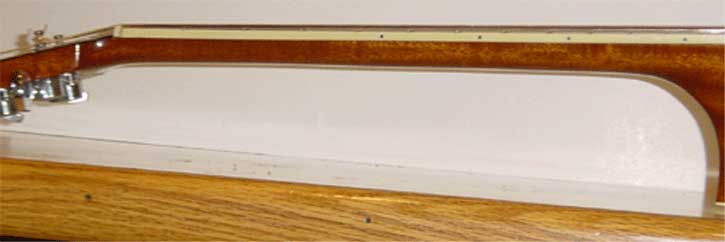
So when you tune your new guitar, all that pressure must be handled by the guitar. Inside the neck is usually a truss rod. This rod extends the entire length of the neck and has the primary responsibility of keeping the neck straight. If the neck starts to move because of the pressure, it will come forward. Lots of guitars are affected by this. But most truss rods can easily be adjusted to bring the neck back into the correct position if it is only slightly out of alignment. Any good guitar shop should offer to adjust the guitar and tune it up for you as a part of the purchase.
Can you mix classic strong with an acoustic guitar?
If a guitar neck moves forward, the distance between the fretboard (which sits on the neck) and the strings will change. The gap at the twelfth fret will be bigger than the gap at the nut (by the tuning pegs). If I am playing a guitar suffering from this problem, I will notice this right away. The action of the guitar may be severely affected and the guitar will never play correctly. This is a deal killer. If the space between the strings and fretboard changes much at all as you climb towards the sound hole, pass it up and go look for one that does not have this problem. I have actually seen a neck tear away from the body because of poor construction and the inability to deal with the pressure of the strings.
Look at the picture above. The distance between the strings and the fretboard does change, but not much. If you try to play chords at the twelfth fret using this guitar, it would be easy. If this neck were warped, the space would vary much more than this and playing chords at the twelfth fret would be considerably harder.
The store manager or luthier may ask for a chance to adjust the neck and correct the action. That is acceptable but do not purchase it until you are absolutely sure it will stay in place. These kind of guitars are all over the place and good stores will not sell you one. This problem can show up in moderately expensive guitars as well as beginner models. Watch for it.
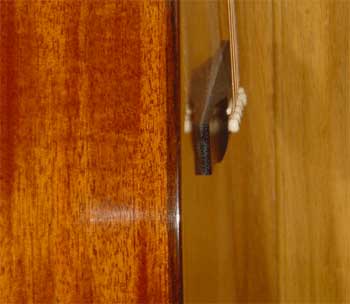 The
nut and bridge. The strings are held on at the top and bottom of the
guitar. The top is where you tune the strings away from the body and the
nut is the piece that holds and aligns the strings so they maintain their
exact position as they cross the fretboard. The bridge is the piece that
is glued on the body just below the sound hole. The bridge contains either
a piece of bone, nylon or plastic, that the strings rest on, just before
they go in to the pegs that actually hold the strings in the holes at
the body. Both the nut and bridge can be taken off and either replaced
or adjusted. Adjusting the bridge and or the nut is a part of a "tune
up" and should be something the music store does during set up. When
this adjustment happens, the action of the guitar may change.
The
nut and bridge. The strings are held on at the top and bottom of the
guitar. The top is where you tune the strings away from the body and the
nut is the piece that holds and aligns the strings so they maintain their
exact position as they cross the fretboard. The bridge is the piece that
is glued on the body just below the sound hole. The bridge contains either
a piece of bone, nylon or plastic, that the strings rest on, just before
they go in to the pegs that actually hold the strings in the holes at
the body. Both the nut and bridge can be taken off and either replaced
or adjusted. Adjusting the bridge and or the nut is a part of a "tune
up" and should be something the music store does during set up. When
this adjustment happens, the action of the guitar may change.
The neck meets the body in a very complex joint. This is the structural heart of the instruments. Combined with the bracing of the body, the neck joint holds the entire load of pressure created by tuning the strings.
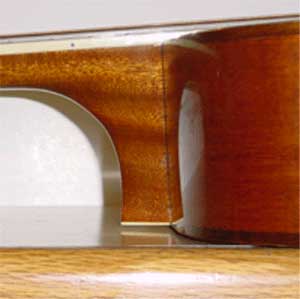 Examine
this joint carefully to make sure it is tight against the body and no
space has opened. If there is a problem with this joint, it is almost
certainly a deal killer. For sure this problem will cause the neck to
appear warped outward. This example is good. There are minor flaws in
the finish but the joint is sound.
Examine
this joint carefully to make sure it is tight against the body and no
space has opened. If there is a problem with this joint, it is almost
certainly a deal killer. For sure this problem will cause the neck to
appear warped outward. This example is good. There are minor flaws in
the finish but the joint is sound.
Examine the guitar by looking down the long axis from the bottom of the body, using the strings as guides. The strings will form a straight line, and the body and neck should follow this straight line. If there is an alignment problem usually you can see it if you look at it like this.
Tuning Pegs. Tuning pegs are much more important than they first seemed to me. Good tuning pegs will hold your guitar in tune and easily adjust the sound when you fine tune it. Poor tuning pegs make it harder to get the pitch exactly correct.
They may force it a few cents higher or not quite right on the note. Most good guitars have quality tuners but guitars under $500 may be questionable. Look for the name on the tuner and inquire as to the quality. Tune it up and down and see for yourself how nicely it responds. Compare it to other tuners on different guitars. Tune the guitar yourself. Don't let a clerk tune it. Remember you are evaluating the instrument.
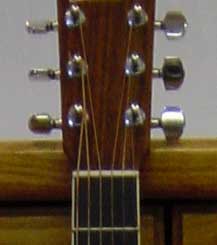 Body
construction. This is the big one. Body construction is based on the
shape of the guitar, the bracing of the body and the material the top
is made from. The shape is more important today than ever before. The
new cutaway designs allow access to the higher registers like never before.
With a cutaway design you can easily reach the fifteenth fret and go even
higher. This has always been a limitation for acoustic guitars and a very
welcome change. It opens a whole new realm of creative possibilities.
All other things being equal, I would opt for the guitar with a cutaway
design.
Body
construction. This is the big one. Body construction is based on the
shape of the guitar, the bracing of the body and the material the top
is made from. The shape is more important today than ever before. The
new cutaway designs allow access to the higher registers like never before.
With a cutaway design you can easily reach the fifteenth fret and go even
higher. This has always been a limitation for acoustic guitars and a very
welcome change. It opens a whole new realm of creative possibilities.
All other things being equal, I would opt for the guitar with a cutaway
design.
Bracing. This is a hard one to examine since it is hidden. You can always bring a small mirror-on-a-stick and take a look at the inside, but you probably would not know what you are looking for, and neither would I. But everything should seem solid and nothing should buzz inside when you play the instrument. If you suspect there may be a problem with the construction of the guitar, have another luthier examine it and provide you with a second opinion.
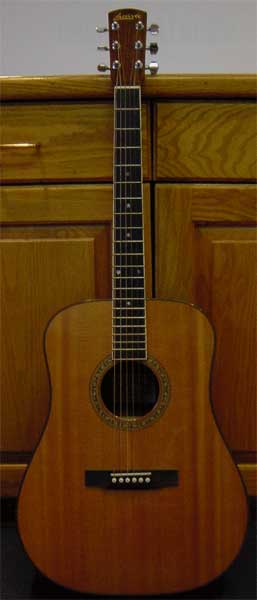 The
solid top. This is something to pay attention to. This characteristic
beyond all the others will determine the fidelity of an instrument. If
a top piece is made of a solid material like spruce it will get better
with age. What happens is this. If you look at the grain of the wood you
can usually see some long straight lines on the top. Inside real wood,
the cell walls break down with age and create long resonating tubes that
amplify the sound of the strings and provide a unique personality. Solid
tops get better with age and are the prime determining factor in the overall
fidelity of an instrument. These instruments may increase in value over
the years.
The
solid top. This is something to pay attention to. This characteristic
beyond all the others will determine the fidelity of an instrument. If
a top piece is made of a solid material like spruce it will get better
with age. What happens is this. If you look at the grain of the wood you
can usually see some long straight lines on the top. Inside real wood,
the cell walls break down with age and create long resonating tubes that
amplify the sound of the strings and provide a unique personality. Solid
tops get better with age and are the prime determining factor in the overall
fidelity of an instrument. These instruments may increase in value over
the years.
A laminate top will not have the ability to form acoustic tube structures and therefore will have a lower quality resonator and never get better with age. I believe you have to spend at least $400 to get into a solid top. Anything below that is probably a laminate top. These guitars depreciate over time. You might think laminate top guitars would not be very good, but I had a couple that were lots of fun to play. One no name guitar that my friend bought for $50.00 at a garage sale distinctly comes to mind. It played like a dream and the sound was passable. I would buy that guitar again today.
It can be hard to tell by looking if a guitar has a solid top or not. Ask the sales guy. Do business with someone you trust. If this is your first guitar, you will almost certainly need some help as you get started.
Electronics. Some guitars will have a built in pickup. This usually comes out of the strap peg on the body. The pickup is installed beneath the bridge and usually not seen. This is my favorite way of installing a pickup in a guitar. It is always available and never in the way. I highly recommend installing a pickup in an acoustic guitar. I think the good pickups sell for about $140. You can buy a pickup you put in the sound hole as a temporary measure. The sound is good but the chord may get in your way.
What you should look for
This is where things get tricky. The range of guitars is from about $125 to easily over $3,000. There are a few major distinctions that may make your decision easier.
The beginner guitars. Usually these are between $125 and $300. The construction is going to be nondescript, and it will have a laminate top. The tuning pegs will probably be an imitation or a lesser brand. The first and most important consideration for guitars in this classification is how does it play. If the guitar fights you, then move on. It must play well to be considered. Everything else including the name is secondary to the feel of playing the instrument. These guitars will not improve with age.
These types of guitars are best used for only short periods of time or as a second guitar. If you are developing your tactile abilities you will quickly be able to tell the difference between this class and the next. I am convinced these guitars will start holding you back when you develop. When your commitment warrants it, treat yourself and get a better guitar. The difference is huge. It is an investment in yourself!
When I took a bike trip one summer, I had one of these kinds of guitars strapped on the back. It went through lots of rainy days. It was a nice piece of lumber.
The next class is an intermediate guitar and the price starts about $350 and extends beyond $750. There is wide variation in this class of guitars. Most will be solid tops and all of them will play differently. You should easily find a guitar in this range you could stay with for many years. The sound should be descent and the action should be stable and easily identified. Some guitars will naturally have a very high action. It is inherent in the set up of the instrument. But the action should be consistent from top to bottom.
Tuning pegs will vary widely. Tuning pegs will be one of the things that contributes to the overall cost. Better tuning pegs usually cost more. If the guitar has good tuning pegs, expect the sales person to point it out. They make a big difference. The finish and the look of the guitar may also elevate the price of the individual instrument.
Evaluating guitars of this class requires some knowledge and feel of guitars in general. When you buy from this group, most people are looking for a guitar that feels good and will be around awhile. If you are just coming up to speed with your playing, it will be difficult to judge the differences that makes one guitar more desirable than the next. It is a good idea to play a bunch of them.
Anything over $1,000 should be considered a very good guitar. This kind of money will bring a fidelity instrument and anything beyond this price range and you get smaller improvements. A $2,500 guitar should play like a dream and have all the excellent characteristics we have covered. Guitars of this class will surly appreciate in value with time and stand out as a fine instrument.
You can get a good player to go play a few and decide for you, but how do you know you like the same things? This approach is widely used and seems to work for a lot of people. I would consider making due with what you have until your abilities rise high enough so you can begin to tell the differences. Then make it a reward for what you have achieved. You will know what you like better later than now. You will have worked hard and earned the right to choose and that always feels good. And above all you will get a guitar that fits your personality. And that will translate into playing it more often. I played over 75 guitars that Summer and did not find the one I wanted. But one thing is for certain, when I felt the right guitar I knew it and we have been best friends ever since.
Okay here is the deal. Classic strings (left picture) are nylon. Even the fat strings that are wound with another metal are nylon core strings. A set of six strings puts about 400 lbs. of pressure on the guitar.
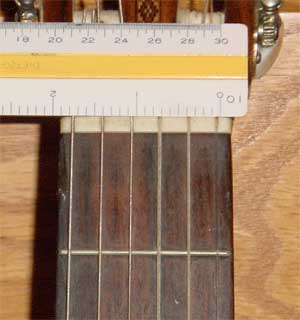
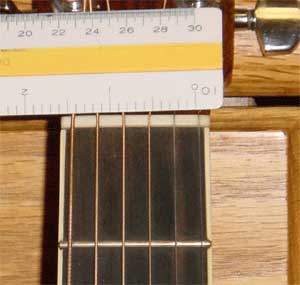 Acoustic strings are steel (right hand picture). The only difference
between the fat ones and the skinny strings are the fat strings have another
winding around the string. The only other difference is the gauge (thickness
of the string).
Acoustic strings are steel (right hand picture). The only difference
between the fat ones and the skinny strings are the fat strings have another
winding around the string. The only other difference is the gauge (thickness
of the string).
Acoustic strings exert about 600 lbs. of pressure on the fretboard.
Acoustic guitars are set up to be able to take more stress, so using nylon or steel strings is okay. Classic guitars, on the other hand are only set up to take about 400 lbs. of stress, so putting steel strings on it will ruin your guitar. Don't do it. Click here to go back